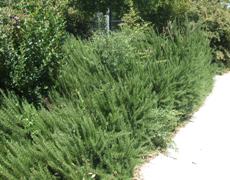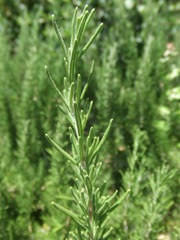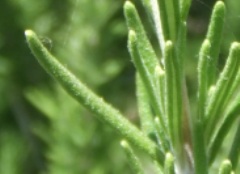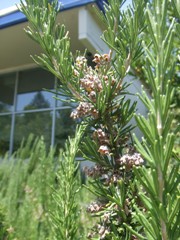Rosemary
Rosemarinus OfficinalisFamily:Lamiales
rosemary2_podcastscript
 The whole Rosemary plant |
 A branch of Rosemary |
 A close up of a Rosemary leaf |
Rosemary's light blue flowers |
Classification:
.Angiosperm, Dicot, evergreenSize:
.The upright form of rosemary ranges from only a foot tall to over six feet high. The leaves are 2-4 cm long and 2-5 mm wide.Identifying Features:
.The leaves are almost needle-like in appearance. The top surface is a light green color while the bottom of the leaf is white. Small, fuzzy hairs cover both sides of the leaf. The leaves cover a large majority of the stem, giving the plant a solid, dense appearance. The structure of the plant is bush-like with many branches, all covered with the small, spiny leaves. During the spring and summer seasons rosemary can be identified by its small, light blue flowers. These flowers are grouped in clusters of three to seven, from approximately the middle to upper half of the stem. Perhaps the clearest identifying feature of the rosemary plant is its distinct smell. The clean, herbal scent (imagine the scent of lavender mixed with that of a pine tree) is suprisingly strong and unique.Location/Habitat:
.Most commonly found in mediterranean climates, such as the environment of the Central Valley of California. Interestingly, it grows naturally on the rugged coastline among the rocks, yet thrives just as well inland, in dry environments. Because of its ability to survive in extremely dry climates, rosemary is commonly found in the midst of droughts and blistering sun. Even though it thrives in direct sunlight, it can also tolerate a foggy environment. It is naturally found most commonly in California, Oregon, Texas, North Carolina and South Carolina. It grows best in slightly alkaline, sandy or rocky soil that is moderately fertile.Flower/Fruit/Reproduction:
.The rosemary plant has 3-7 blue flowers covering its stem during the spring and summer seasons. These flowers are hermaphrodites, which means that they contain both female and male organs. The flowers are also a means of attracting bees and other insects which assist in pollination. Rosemary can also be propagated from cuttings. This means that a stalk cut from one plant can be replanted to grow into an entirely new, independent plant.Water/Sun Requirements:
.Rosemary grows best in dry environments with plenty of sunlight. Its love of sunlight is evident by the abundance of flowers that the plant produces when exposed to high sun exposure. Rosemary needs very little water and therefore requires that the soil is light and provides good water drainage for the plant. This is extremely important because an excess of water causes the plant's roots to rot.Special Adaptations:
.The rosemary plant's pollen is specially adapted to withstand fluctuating temperature changes, common to mediterranean climates. The plant can tolerate temperatures as low as -10 degrees Fahrenheit.Rosemary's leaf structure is also greatly adapted for survival in hot climates. The tiny hairs covering the leaves reduce evaporation at the surface of the leaf. The waxy surface of the leaf also helps control water loss in the plant, ensuring that it retains enough moisture.
Other Info:
.Rosemary is the herb of friendship and remembrance. In fact, it has been used throughout the centuries as a token of esteem between close friends and during funerals to inspire good memories of the deceased. In ancient Greece, young maidens would often wear it in their hair to help improve their memory. Rosemary is used as a popular cooking herb in many parts of the world, especially Italy (both the leaves and the flowers are edible). Rosemary is an extremely common herb to use while preparing lamb, shellfish and fish (especially salmon), pasta and sauces. The Italian flat bread focaccia is made by sprinkling rosemary in the dough directly before it is baked.Rosemary is also used for medicinal purposes. For example, caffeic acid and derivative rosmarinic acid are both antioxident compounds found inside the rosemary plant that are being studied as a cure for cancer. Oil of rosemary is also used as aromatherapy for stress relief and even to treat hair loss.
Reference Sources/Links:
.Fish & Wildlife ServicesWikipedia
Floridata-Rosemarinus Officinalis
Natural Standard
Plants for a Future
Sunset
Springerlink-Protoplasma
Created by Kristy W. 2007
